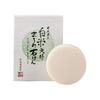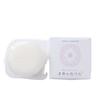✅ [Originating from Kyoto, a traditional Japanese city] Seimei Shrine, which enshrines Abe no Seimei, an onmyoji (Japanese fortune teller), is located in Kyoto on the Myojin Shrine side. Walk west along Ichijo Street, famous for Ichijo Modoribashi Bridge, and down Kuromon Street, and you will find Hakusanyu, which has been around for 120 years. It is a member of the Kyoto Prefecture Public Bath Industry and Lifestyle Hygiene Trade Association and has supported Kyoto's bath culture. It has a deep bath, shallow bath, medicinal bath, sauna, and cold bath, and has a Kyoto-like atmosphere. This is "Kuromon Ichijo", a Nishijin soap made by Hakusanyu, which has been in the bath business for generations.
✅ [Used by Kyoto beauties who care about their skin] This face wash contains beauty ingredients for Kyoto beauties. The main ingredient is "silk", which can be said to be a symbol of beauty. Currently, most silk is imported from overseas, but the silk used here is domestically produced. Raw silk was once Japan's main export, and Nishijin soap is committed to using domestically produced silk in order to preserve the silk culture and technology built by our predecessors.
✅ [Cosmetic soap that can be used on the whole body] It can be used safely on the body and children as well as for washing the face. Nishijin Soap "Kuromon Ichijo" is a soap for washing the face. The skin on the face in particular is exposed to the outside air, UV rays, and sebum, so daily care is required. Gently wash away the dirt of the day with this soap that has been carefully crafted with great care.
✅ [Ingredients carefully selected by hot water professionals] Contains no additives, silk, olive oil, palm kernel oil, rice bran, and other ingredients essential to beauty. Nishijin Soap's specialty soaps are made by Marubishi Soap, which was founded in 1955. While competitors moved toward mass production and industrialization one after another, the first president continued to make soap using the traditional "kettle-boiled method." This manufacturing technique was passed down to the second generation. We will continue to protect the techniques of our artisans, who are now few in number in Japan.
✅ [Experience is everything when it comes to soap making] This product is made in Japan with a serious approach to craftsmanship and safety. Nishijin soap does not skimp on the selection of materials. The "soap base" made from carefully selected raw materials is also handmade. It is left to rest and mature for a long time, so even sensitive skin will not feel tight after washing. Among the kettle-boiled methods, we are particular about the "water-boiled method", which is the more time-consuming and labor-intensive method. We adjust the heat according to the season, temperature, and humidity, and accurately judge the state of saponification by visual inspection. This is to ensure that the soap contains a lot of glycerin, a moisturizing ingredient. What is necessary to make Nishijin soap is time for natural drying. The hardened soap is removed from the frame, cut, and then left to dry for several tens of days to several months. It is because of this time that the feel of the soap is mild and you can enjoy the texture unique to handmade products.
Hakusanyu Kuromon Ichijo, founded 120 years ago in Kyoto. Fully supervised by "The wisdom of history for you". Facial soap Nishijin Soap ~ NISHIJIN Silk included Skin care Facial soap Naturally dried Handmade Made in Japan























![Makomo Soap 85g Made In Contains Naturally Grown Makomo Handmade Soap For Sensitive Skin and Face Washing [Makomo JAPAN] Japan, Additive-free,](https://img.joomcdn.net/0c700b0b93d9467c64052c9251ba45a885b3f211_100_100.jpeg)





![For Sensitive Nesno Balance Wash for Sensitive Low Contains Hot Spring Mineral No Allergy Tested [Soap Skin] 100g, Skin, Irritation, Ingredients,](https://img.joomcdn.net/7d495992d550b93977903ea95d7c1195792e3f88_100_91.jpeg)





![Soap Factory KURIYA Body Wash 2 Pieces 90g X 2 Soap That Is Gentle On the Inspired by Baby Sensitive Dry Body Solid Cold Process [Body Skin, Bathing]](https://img.joomcdn.net/c0d4192244e06db2b0983bda9a371bbc74706d35_100_71.jpeg)